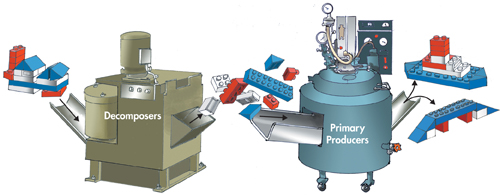Food Webs In most ecosystems, feeding relationships are much more complicated than the relationships described in a single, simple chain. One reason for this is that many animals eat more than one kind of food. For example, on Africa's Serengeti Plain, herbivores, such as zebras, gazelles, and buffaloes, often graze upon several different species of grasses. Several predators such as lions, hyenas, and leopards, in turn, often prey upon those herbivores! Ecologists call this network of feeding interactions a food web.
▸ Food Chains Within Food Webs The Everglades are a complex marshland ecosystem in southern Florida. Here, aquatic and terrestrial organisms interact in many overlapping feeding relationships that have been simplified and represented in Figure 3–9. Starting with a primary producer (algae or plants), see how many different routes you can take to reach the alligator, vulture, or anhinga. One path, from the algae to the alligator, is the same food chain you saw in Figure 3–7. In fact, each path you trace through the food web is a food chain. You can think of a food web, therefore, as linking together all of the food chains in an ecosystem. Realize, however, that this is a highly simplified representation of this food web, in which many species have been left out. Now, you can begin to appreciate how complicated food webs are!
▸ Decomposers and Detritivores in Food Webs Decomposers and detritivores are as important in most food webs as other consumers are. Look again at the Everglades web. Although white-tailed deer, moorhens, raccoons, grass shrimp, crayfish, and flagfish feed at least partly on primary producers, most producers die without being eaten. In the detritus pathway, decomposers convert that dead material to detritus, which is eaten by detritivores, such as crayfish, grass shrimp, and worms. At the same time, the decomposition process releases nutrients that can be used by primary producers. Thus, decomposers recycle nutrients in food webs as seen in Figure 3–8. Without decomposers, nutrients would remain locked within dead organisms.
 In Your Notebook Explain how food chains and food webs are related.
In Your Notebook Explain how food chains and food webs are related.
BUILD Vocabulary
ACADEMIC WORDS The verb convert means “to change from one form to another.” Decomposers convert, or change, dead plant matter into a form called detritus that is eaten by detritivores.
VISUAL ANALOGY

Figure 3–8 Earth's Recycling Center Decomposers break down dead and decaying matter and release nutrients that can be reused by primary producers.
Use Analogies How are decomposers like a city's recycling center?
d
Table of Contents
- Formulas and Equations
- Applying Formulas and Equations
- Mean, Median, and Mode
- Estimation
- Using Measurements in Calculations
- Effects of Measurement Errors
- Accuracy
- Precision
- Comparing Accuracy and Precision
- Significant Figures
- Calculating With Significant Figures
- Scientific Notation
- Calculating With Scientific Notation
- Dimensional Analysis
- Applying Dimensional Analysis




